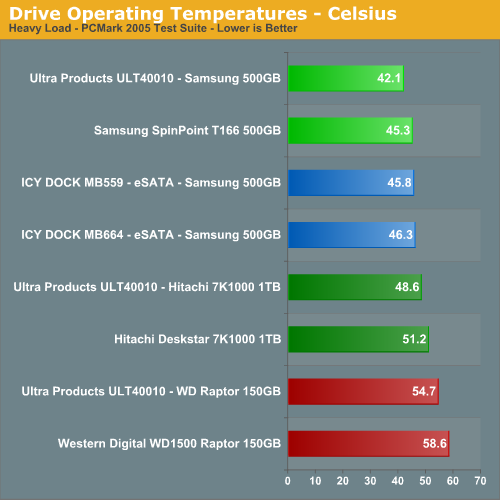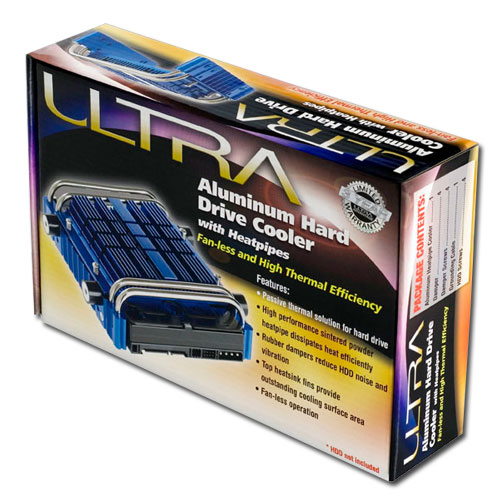Test Results


Clearly, the Ultra Products ULT40010 provides superior heat dissipation compared to a bare drive in a standard 3.5" HD case mount. Our Samsung drive, already having earned its reputation as one of the coolest hard drives to grace our test labs, not only runs almost two degrees cooler when mounted using the ULT40010, but it also takes longer to reach this peak temperature. Out of curiosity, we worked the hard drive out in a long (30GB) archive process to see if we could make the heat climb any further, and were only successful in reaching a maximum threshold of one degree higher (43C). The additional surface area of the Ultra cooler (with its cooling fins and heat pipes) allows sufficient thermal transfer to make a noticeable difference, even in our relatively cool-running Samsung drive.
The results were even better with our Hitachi 7K1000 and Western Digital Raptor drives. Idle temperatures on the Hitachi drive only dropped about 1%, but load temperatures dropped over 5% in our test system. The 150GB Raptor has the highest idle and operating temperatures of any hard drive in our labs. As such, this is the drive that would tell us just how well the ULT40010 is designed as a passive cooling unit. We were not disappointed as idle temps dropped 3% and load temperatures decreased over 7%. Once again we ran our 30GB archive test and temperatures did not vary more than 1% over the course of several archive sessions.
Conclusion

Ultra also advertises that the cooler will reduce noise compared to a standard test setup, but we were unable to discern any difference in our test bed. Presumably, Ultra's claim refers to the rubber mount contacts that reduce case vibration compared to cheaper PC cases that use steel-only hard drive housings. While this claim is certainly true, there has been a trend in the midrange to high-end PC cases to have some type of rubber or foam in place wherever storage devices will contact the case chassis. Given the MSRP of $43 for the ULT40010, it stands to reason that anyone looking at this cooler as an option already has a good quality case with vibration dampening hardware inside. While this does potentially remove one of the items in Ultra's favor, it doesn't take away from the fact that the ULT40010 performs well as a passive hard drive cooler, which is its primary selling point.
The Ultra cooler does what it says, but it doesn't perform miracles. Good active cooling solutions tend to perform better than good passive cooling solutions. While this cooler is indeed an example of a very good passive cooling solution, it does mean that it has somewhat less impact than it likely could if it had (for example) a fan mounted on the top. The trade-off, however, is well worth it to users looking for a case that runs as close to silently as possible. For that reason, Ultra Product's ULT40010 hard drive cooler is an excellent choice for HTPC users, and anyone seeking to help mitigate a hard drive heat problem without adding additional noise to their PC configuration.


Clearly, the Ultra Products ULT40010 provides superior heat dissipation compared to a bare drive in a standard 3.5" HD case mount. Our Samsung drive, already having earned its reputation as one of the coolest hard drives to grace our test labs, not only runs almost two degrees cooler when mounted using the ULT40010, but it also takes longer to reach this peak temperature. Out of curiosity, we worked the hard drive out in a long (30GB) archive process to see if we could make the heat climb any further, and were only successful in reaching a maximum threshold of one degree higher (43C). The additional surface area of the Ultra cooler (with its cooling fins and heat pipes) allows sufficient thermal transfer to make a noticeable difference, even in our relatively cool-running Samsung drive.
The results were even better with our Hitachi 7K1000 and Western Digital Raptor drives. Idle temperatures on the Hitachi drive only dropped about 1%, but load temperatures dropped over 5% in our test system. The 150GB Raptor has the highest idle and operating temperatures of any hard drive in our labs. As such, this is the drive that would tell us just how well the ULT40010 is designed as a passive cooling unit. We were not disappointed as idle temps dropped 3% and load temperatures decreased over 7%. Once again we ran our 30GB archive test and temperatures did not vary more than 1% over the course of several archive sessions.
Conclusion

Ultra also advertises that the cooler will reduce noise compared to a standard test setup, but we were unable to discern any difference in our test bed. Presumably, Ultra's claim refers to the rubber mount contacts that reduce case vibration compared to cheaper PC cases that use steel-only hard drive housings. While this claim is certainly true, there has been a trend in the midrange to high-end PC cases to have some type of rubber or foam in place wherever storage devices will contact the case chassis. Given the MSRP of $43 for the ULT40010, it stands to reason that anyone looking at this cooler as an option already has a good quality case with vibration dampening hardware inside. While this does potentially remove one of the items in Ultra's favor, it doesn't take away from the fact that the ULT40010 performs well as a passive hard drive cooler, which is its primary selling point.
The Ultra cooler does what it says, but it doesn't perform miracles. Good active cooling solutions tend to perform better than good passive cooling solutions. While this cooler is indeed an example of a very good passive cooling solution, it does mean that it has somewhat less impact than it likely could if it had (for example) a fan mounted on the top. The trade-off, however, is well worth it to users looking for a case that runs as close to silently as possible. For that reason, Ultra Product's ULT40010 hard drive cooler is an excellent choice for HTPC users, and anyone seeking to help mitigate a hard drive heat problem without adding additional noise to their PC configuration.










31 Comments
View All Comments
Ajax9000 - Monday, November 5, 2007 - link
So you take a 3.5" drive out of a 3.5" bay, wrap it in a metal shroud, stick it in a 5.25" bay and its temperature goes down ...Well, how much would the teperature have gone down if you just mounted the bare drive in the 5.25" bay?????????????
SunAngel - Sunday, November 4, 2007 - link
The following comments are not directed towards the article itself, but the product.It amazes me with all the "hotroding" going on in computers. A hard drive cooler? Come on, get real. If your hard drive is running hot I think you have more serious problems than a hard drive cooler will solve. Like maybe you need to have better case cooling. But, I guess there are individuals out there that will fall for this type of product.
At $43 MSRP, this should put this product in the grave real quick. For $43 you could purchase a better cooling case or upgrade the cooling the case you already have. I feel so ashamed when I read reviews of these types of products. I always think, "Damn, if this persons wasn't so immature they would see this product is worthless." I don't know why I feel ashamed, hell, its not my money. It as if a bully is taking money from a baby. I just want to bash the nose to back of their skull. Yet, I know we are different and have different needs and tastes.
So I'm going to end my jibber jabbing and let bygons be bygons.
mechBgon - Sunday, November 4, 2007 - link
Not to be a language Nazi, but with reference to the title, the phrase is "put it through the wringer," from the olden days when that was part of doing laundry. :)mindless1 - Sunday, November 4, 2007 - link
So we have heatpipes or at least heatpipe looking *things*, but what's missing? The heatpipes should be connected to fins to increase their surface area, that is essentially the point of heatpipes. Having that fin plate arrangement on top is far less effective than it ought to be.For this reason I'd have to consider the product misengineered, before even considering that if it were well engineered it would still make minimal difference unless the drive was installed in some hot cramped place where it shouldn't have been w/o another cooling method already like passive intake holes in front of the bay or a fan. A couple degrees isn't even worth the time to install this if they gave it to you for free.
If it had LEDs and the heatsink was giganormous enough that you had to buy another case with it's own zip code just to use it, then it would at least impress the younger crowd. This product has free after rebate written all over it.
RichUK - Sunday, November 4, 2007 - link
What a useless bit of kit. This is akin to putting spinners on your pimped out Hummer.jmv - Saturday, November 3, 2007 - link
What does a "7% decreased load temperature" mean?Is that 7% with respect to
a) ambient room temperature
b) ambient case temperature
c) 0 C
d) 0 Fahrenheit
d) absolute zero (-273 C)
I suspect it's c), but that would be a completely arbitrary scale. For example, the result would be different if measured in Fahrenheit!
Dave Robinet - Saturday, November 3, 2007 - link
7% drop versus what the drive originally ran at (ie. without the cooler).SO:
Without the heatsink, the Raptor was 58.6 degrees. With the heatsink, it was 54.7. That difference (3.9 degrees) is roughly 7% of the original 58.6 degree temperature (actually 6.665%).
Sorry if that wasn't clear. Thanks for reading, and for the smile this morning. :)
dnd728 - Saturday, November 3, 2007 - link
Hmm... You shouldn't really do this. It would only mean anything if you use the ambient temperature as your base. 0C is simply an arbitrary point chosen because that's when water freezes. It has no relevance here - it means nothing.Woodchuck2000 - Saturday, November 3, 2007 - link
Spot on... Seriously, before you write an article about practical thermodynamics, take a few seconds to actually do some research. The only meaningful reading you can take here is the difference beween drive and ambient temperature. You don't actually specify how you measure the drive temperature, and you don't consider the effects of the different mounting mechanisms within the case - the default 4 in 3 hard drive mounting of the Stacker 830 will be lousy for convective cooling compared with the 5.25" bay mounts which have clear air above and below (unless you've mounted between your two optical drives - again, not stated). This is, in the end, a pointless product which makes no practical difference to your rig and I would expect a site of Anandtech's calibre to actually say so.puffpio - Friday, November 2, 2007 - link
any thermal paste used?Totally passive system would be sweeeeeeeet